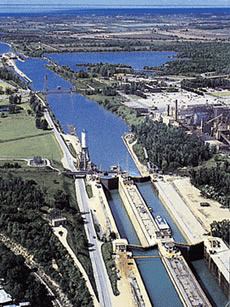The seaway opened to commercial traffic on April 25, 1959. The total cost was $470 million, of which Canada provided $336.2 million and the United States $133.8 million. Canada’s St. Lawrence Seaway Management Corporation manages 13 locks, while the U.S. St. Lawrence Seaway Development Corporation manages two locks.
The hydroelectric facilities are administered by Ontario Power and the New York State Power Authority. Depending on weather conditions and ice management, the seaway is generally open from April to mid-December, approximately 250 days per year.
There are seven locks between Montreal and Lake Ontario, a distance of 187 miles. Each lock is 766 feet in length, 80 feet wide, and 30 feet deep, and all channels are dredged to a depth of 27 feet. To ensure proper depth it was necessary to flood some areas, displacing and relocating residents of river towns. Technically not part of the seaway, the two Soo Locks in Sault Ste. Marie, Michigan, are slightly larger and connect the upper Great Lakes with Lake Superior.
  |
Ninety percent of the freight shipped consists of bulk commodities. Westbound traffic primarily carries cargoes of steel, coal, and iron ore; 40 percent of eastbound cargo is grain. Inter-lake trade accounts for four times the tonnage handled for international markets.
In recent years, proposals by the U.S. and Canadian governments to deepen the seaway and enlarge its locks have met with resistance. Those who seek to expand seaway traffic point out that the St. Lawrence project is operating at only half the capacity envisioned when the project began in the 1950s, while another, even older, water "highway", the Panama Canal, is achieving full capacity and more.
Opponents of the seaway’s expansion fear damage to water quality in the world’s greatest freshwater system and point to damage already caused by invasive animal and plant species introduced by shipping on the seaway. Studies claim that 182 nonnative species have entered the Great Lakes system, two-thirds of them since 1959 when the seaway opened.
